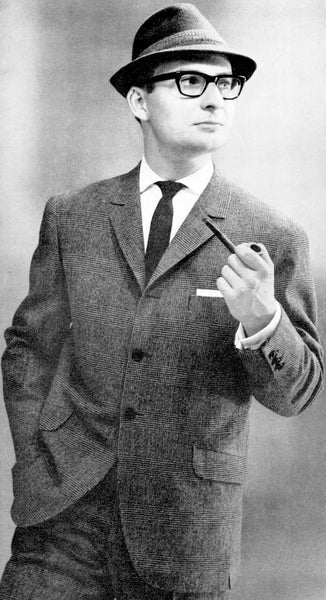
Over the last decade, the three-button jacket has all but disappeared. In the 1990s and early 2000s, they were prevalent. But coinciding with the advent of slimmer fits, the three-button jacket has almost vanished. You could chalk this up to the fickleness of fashion, and that may be true. However, I think there are several limiting and subtle factors that are preventing the three-button from making a comeback.
Jacket length
If you’re old enough to order an alcoholic beverage, than you might have noticed that jackets are significantly shorter than they were in the last decade. It stands to reason that the loss of a couple of inches of real estate would lend itself to fewer buttons. However, there have been eras when jackets were on the shorter side and three-buttons still existed.

The Rolling Stones, 1965. Agence France-Presse — Getty Images
In the picture above, several members of the Rolling Stones are wearing relatively short jackets with three buttons. Therefore, jacket length can’t be the sole reason that the third button has disappeared.
Higher button stance
Most current-day suits have a relatively high top button compared to other fashion eras. The location of this button is referred to as the “button stance” or “button stand”. With a higher button stance, the second button is encroaching on the third’s real estate, reducing the ability to place a third button in its natural location. The higher placement is partially for aesthetic reasons, but it’s mostly necessary to provide maximum waist suppression by anchoring at the true waist (slimmest section of the torso just below the ribcage). If the button is placed lower, the jacket waist will have to be cut larger to accommodate the circumference of the hips.
Waist suppression
There are quite a few stylistic similarities between 1960s men’s suits and the modern version, but the most noticeable difference is the lack of waist suppression – the 1960s jacket had a considerably boxier cut. Due to the similarities, the roots of the modern suit are generally attributed to 1960s more than any other era. Though there is a resemblance – both are historically on the shorter side with slim, flat front trousers and sometimes narrow lapels – I think the comparison has become a little exaggerated, due in part to the not entirely faithful wardrobes of period pieces like Mad Men.

Early 1960s suit, source unknown
In the first half of the 20th century, the “sack jacket,” a straight cut jacket with very little hourglass shaping, was commonplace. Today, just about all jackets have darts running vertically from the chest to the pockets, as well as a separate panel that runs vertically from the armhole, for a total of six panels:

The image above depicts the left side of a modern six panel sewing pattern with a chest dart. On a sack jacket, the dart would be absent and the chest and side panels would be combined into one piece. The dart and additional panel allow for more pronounced waist suppression. In any garment, darts and panels permit a rapid increase or decrease in circumference – in this case from the chest to waist. An average man has a difference of six or seven inches between his chest and waist (more for bodybuilders and less for those carrying extra weight in the midsection). Today’s norm of a large chest-to-waist ratio would be nearly impossible using a sack jacket pattern:

In the image above, a cylinder is serving as a simplified proxy for a torso. If the midsection is cinched up without any darting/panels, the fabric has nowhere to go and becomes creased and wrinkled.
By contrast, darts allow for smooth shaping between the different circumferences:

While jacket length and button stance are straightforward enough, the effect that waist suppression has on the number of buttons is less obvious, though I think it is the primary reason that two-button jackets are so pervasive. If jackets in the 1960s dropped two or three inches from chest to waist vs. today’s norm of six or seven, this would create a sharper angle in the modern jacket. Because of this more extreme taper, it would stand to reason that the lower chest/sternum would be significantly tighter as a result. Since the lower chest/sternum is the traditional location of the top button on a three-button jacket, any tightness in that area could impede the function of the top button.
Chest allowance
The chest allowance – the amount of extra fabric added to a garment over the body measurements – in modern suits is also considerably less than it has been in most three-button eras. In addition to the chest tightness associated with a more fitted waist, as discussed earlier, a closer fitting chest would further restrict the ability to close the top button of a three-button jacket.
So is the three-button jacket extinct?
After a decade of historically shorter and tighter jackets without a dramatic reversal in this trend, it seems unlikely that the three-button jacket is due for major comeback anytime soon. However, fashion is cyclical and there have been some signs of a shift away from the hyper-trim style – jacket length is a touch longer than it was a few years ago, lapels are a hair wider. I believe that the very baggy fit of the 1990s and early 2000s was more of an anomaly than the current fitted trend. But as I’ve written before, these styles are at opposing sides on the spectrum of historical extremes, so I’d put my money on a continued incremental easing of the ultra-fitted trend, but probably not enough to accommodate a third button in the foreseeable future.

Super article.
I’m not involved in the fashion industry nor am I “armchair” tailor; however, I have a fairly comprehensive collection of suits from every decade beginning in the 1870’s and progressing to date. I believe something that should have been mentioned which greatly affects the overall appearance of men’s suits is silhouette; I mean overall silhouette…that includes the trousers. I have a fairly “veed” back and small waist (~42 jacket, 28 waist). My personal favorite vintage suits are those from about 1959 through the middle 1960’s (lots of Botany 500’s, tailored by Daroff). The jackets are usually referred to as “boxy” while the trousers are “peg-legged”. For me, this “triangular” overall shape works well even without the “tailoring” just above the hips often seen in later years (and today). Two-button models work best for me, but I have many three-button jackets as well. I think the reason the three- closure fronts of yore work well lies in the spacing of the buttons. Three-button models of the ’90’s an ’00’s had spacings that were further apart than many that were available during the Kennedy/Johnson years; although suit- and sportcoats were available with wider-spaced buttons then. I’ve often heard those jackets referred to as “collegiate”, “academic”, or “New England”.
give me three button baggy fit pin stripes and window panes looks very sharp .
Fantastic article! Thanks for sharing.
I would prefer to refer to early 19th century and beyond three-button jackets to find an appropriate fitting model. If you observe illustrations from this period you will notice most of the jackets possess a characteristic mostly absent from modern day sport coats : drape. Closing a jacket with two-buttons (on a three-button jacket) must be accompanied with form fitting shape at the waste. This works well with fabric combinations containing silk or linen.
@Dalemarie Davis glad you enjoy the blog! If you’re ever in DC, please feel free to drop by.
@T Ross most brands offer them still, but do the vast majority of their business in 2 button. The three roll is functionally a 2 button however. When I do make 3 buttons, they almost always have the roll.
@Pete fashion is cyclical, so I’m sure at some point we’ll reverse course.